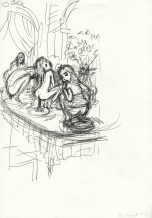| Revista Umělec 1998/3 >> Volume right Gillian Wearing | Lista de todas las ediciones | ||||||||||||
|
|||||||||||||
Volume right Gillian WearingRevista Umělec 1998/301.03.1998 Karel Císař | geneva | en cs |
|||||||||||||
|
"A month after the opening of Gillian Wearing’s exhibition, the ambitious Center of Contemporary Art in Geneva is empty. An older custodian bathes in rays of the Alps sun shining through willfully raised blinds, and only one out of six videos works. After the shy star of the London scene had left and the last bottle of Pinot Noir had been finished, nobody is interested in the show any more. It should be the contrary without a doubt. Contrasting with the current, a bit cold and overintellectualized collection of the museum, which is located in a reconstructed factory, her exhibition is very open and full of emotions. Shown here were the Turner Prize winning black and white film Sasha and Mum (1996) projected on a screen, 16mm films 10-16 (1997) made for the BBC, a family idyll 2 into 1 (1997), and Byotime 1 and 2 (1997).
With their mutated gesture effect, the backwards played shots of a quarrel between a mother and her daughter in Sasha and Mum, remind of the same effect used in the “red lounge“ in David Lynch’s Twin Peaks. Love and hatred are rid of their contradiction in a space of disoriented causality. Perhaps they are more of a continuous energy field of discharges of accumulated emotions. Strangling is just a very strong embrace. Stringent, realistic, yet extraordinarily brutal shots of the mother hugging, tugging, petting her half undressed daughter, contain certain dark beauty in their effect. Unnatural movement of the mother’s simple flower-pattern dress is almost baroque despite its civil appearance. While motion was dominant in her previous works (Dancing in Peckham, 1994, showing Wearing dancing ferociously in a South London shopping mall and playing Gloria Geynor and Nirvana music in her mind; slight reprise, 1995, a compilation of metal fans playing air guitars, imitating their idols), Wearing’s later videos almost lack it. Her video 60 Minutes of Silence (1996) is almost radical in this respect with a photograph-like image of a group of 26 police officers standing silent. Her technique is now closer to TV documentaries than feature films. In her seven short films entitled 10-16, Wearing lets children aged 10 to 16 tell their opinions on life. Their confessions, however, are told by adults whose mimicry are synchronized with the children’s voices. The short films echo the issue of media and their manipulation in an extraordinarily strong way. While in the Sasha and Mum video, the sound was limited to backwards played animal-like sobs and laughter, in 10-16 the authentic story placed into somebody else’s mouth plays the key role. Socially and racially varied group of adults talk about their future they have in fact already lived. The future has passed, people don’t want to play with us all the time and our parents don’t give us enough money. Plans and dreams do not become memories, on the contrary they are hidden traumas emerging from confessions Wearing provides a space for. In 1994, she shot ten such confessions without absolution. People in disguise admit thefts and sexual deviations after they had responded to her ad in Time Out: “Confess all on video. Don’t worry, you will be in disguise. Intrigued? Call Gillian...“ The authentic character of the confessions is intensified by cliche that may be easily overlooked and that Wearing took over from documentaries. A young man describes his sexual fantasies through the mouth of a middle-aged man sitting opposite the interviewer who disappears slowly from the shot as the man overcomes his barriers. A naked midget, with a child’s voice, scolds his lesbian mother and finally closes the door of his bathroom. The world of intimacy Wearing lets us enter is in the end also closing its door. Wearing used similar process of synchronization in her 2 into 1 video. Intimate confessions of a lonely person, however, are not transformed into the mouth of another. The stories are strategically exchanged among members of a close social group - a family represented by a mother and her two sons. The space of mirroring among the actors and viewers is jointed into itself. The mother’s harsh evaluation of her sons comes from her own mouth. Gillian Wearing’s critical anthropology wreathes fibers of power relations that set the individual’s position in the society. She openly uses the often unreflected faith people in the 90‘s entrust on electronic media. They still want to express themselves, to say something or at least record their story for those who will want listen. Gillian Wearing does not only document their stories, she tries to intensify them by all accessible means to break into our disability to hear others and particularly ourselves. What else is left? "
01.03.1998
Artículos recomendados
|
|||||||||||||
|
04.02.2020 10:17
Letošní 50. ročník Art Basel přilákal celkem 93 000 návštěvníků a sběratelů z 80 zemí světa. 290 prémiových galerií představilo umělecká díla od počátku 20. století až po současnost. Hlavní sektor přehlídky, tradičně v prvním patře výstavního prostoru, představil 232 předních galerií z celého světa nabízející umění nejvyšší kvality. Veletrh ukázal vzestupný trend prodeje prostřednictvím galerií jak soukromým sbírkám, tak i institucím. Kromě hlavního veletrhu stály za návštěvu i ty přidružené: Volta, Liste a Photo Basel, k tomu doprovodné programy a výstavy v místních institucích, které kvalitou daleko přesahují hranice města tj. Kunsthalle Basel, Kunstmuseum, Tinguely muzeum nebo Fondation Beyeler.
|






























 We Are Rising National Gallery For You! Go to Kyjov by Krásná Lípa no.37.
We Are Rising National Gallery For You! Go to Kyjov by Krásná Lípa no.37.
Comentarios
Actualmente no hay comentariosAgregar nuevo comentario